新概念英语第三册倒装句课件(共53张PPT)
文档属性
| 名称 | 新概念英语第三册倒装句课件(共53张PPT) |

|
|
| 格式 | pptx | ||
| 文件大小 | 2.9MB | ||
| 资源类型 | 教案 | ||
| 版本资源 | 新概念英语 | ||
| 科目 | 英语 | ||
| 更新时间 | 2023-10-05 18:22:54 | ||
图片预览

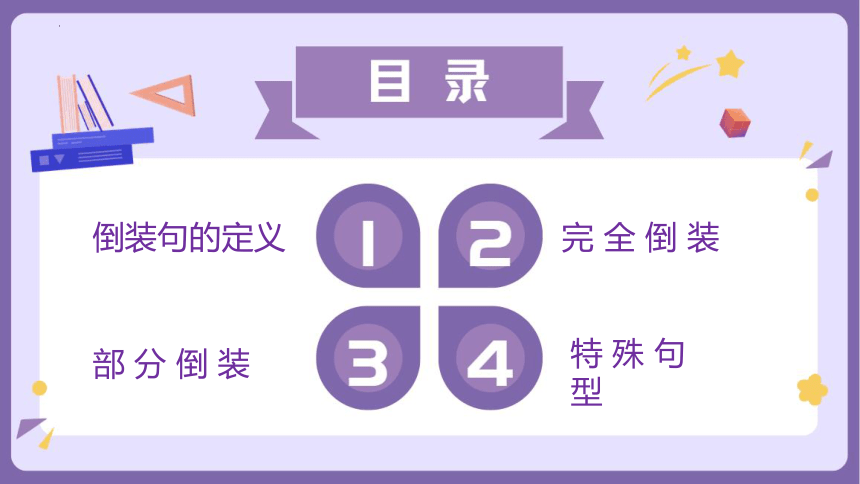

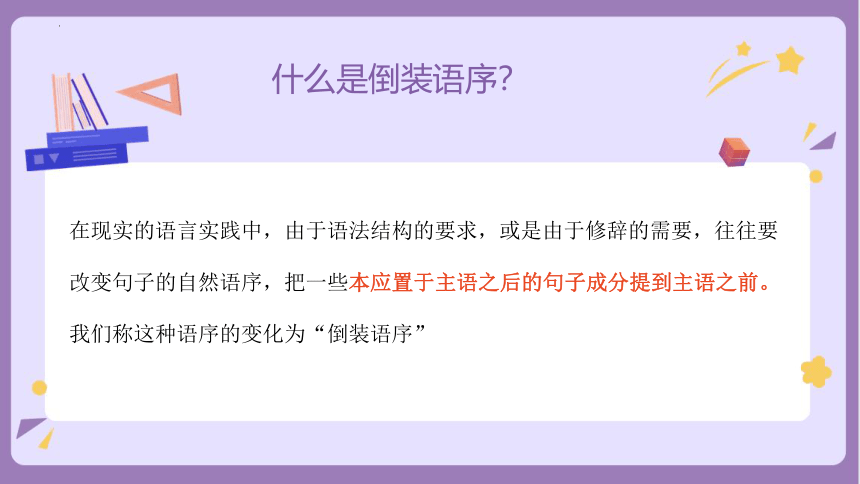
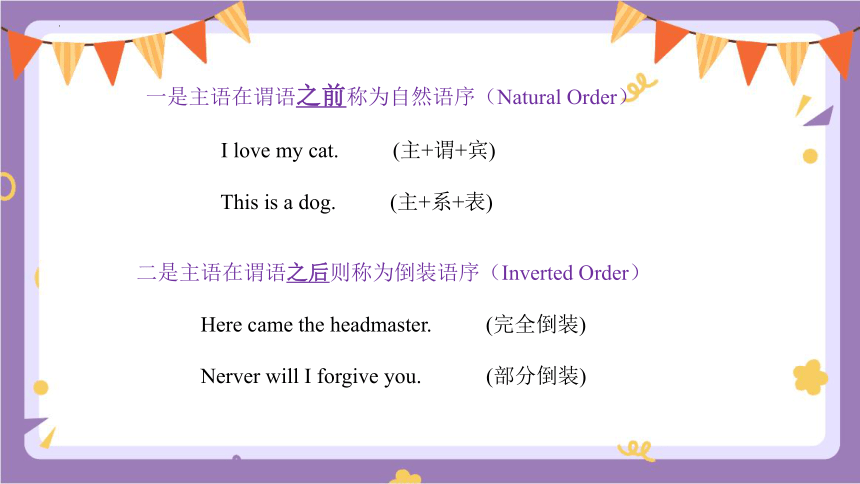

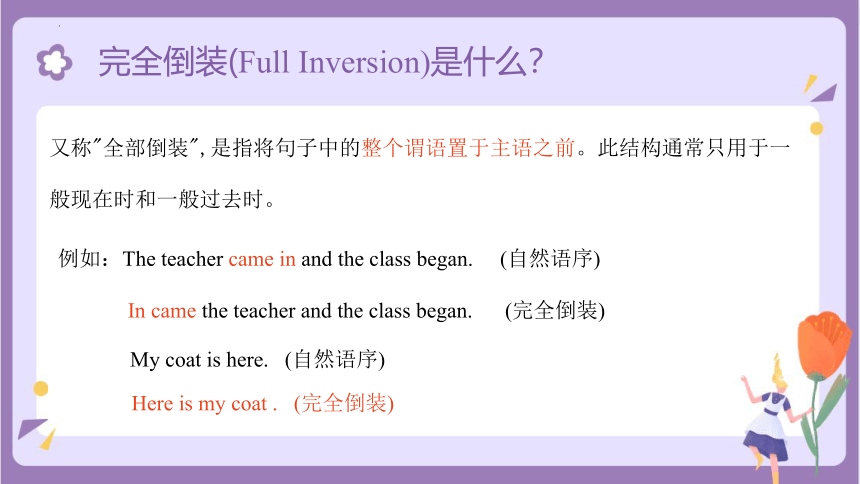
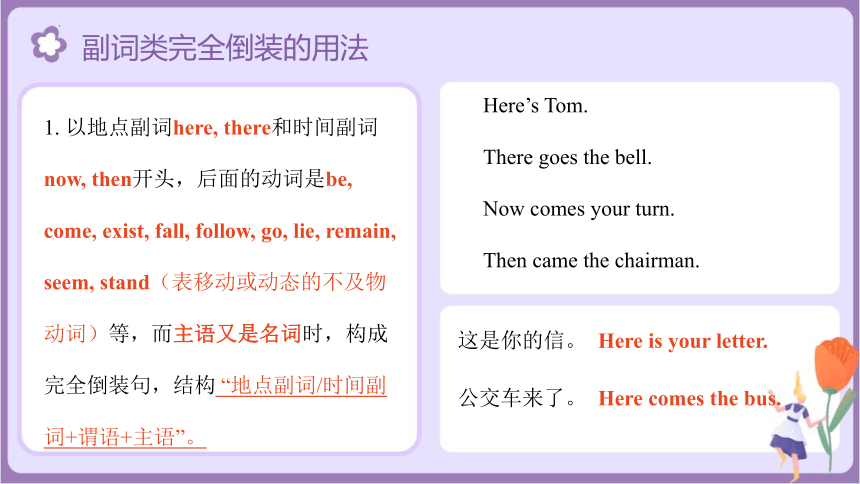

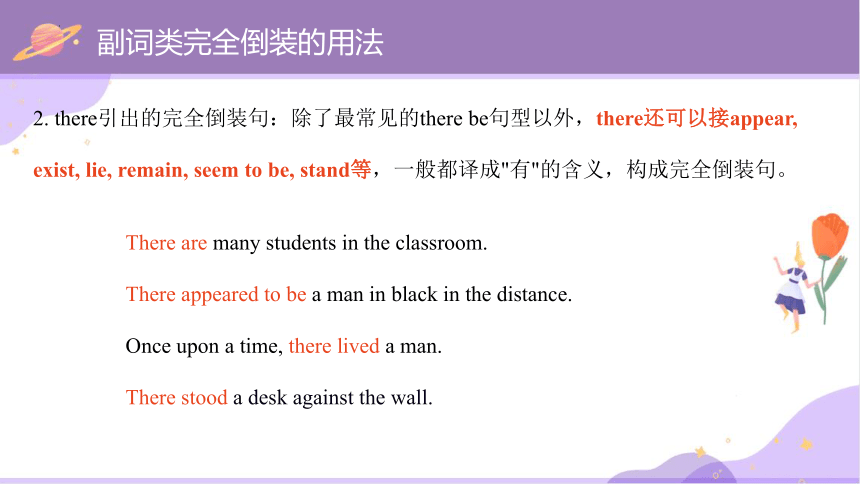
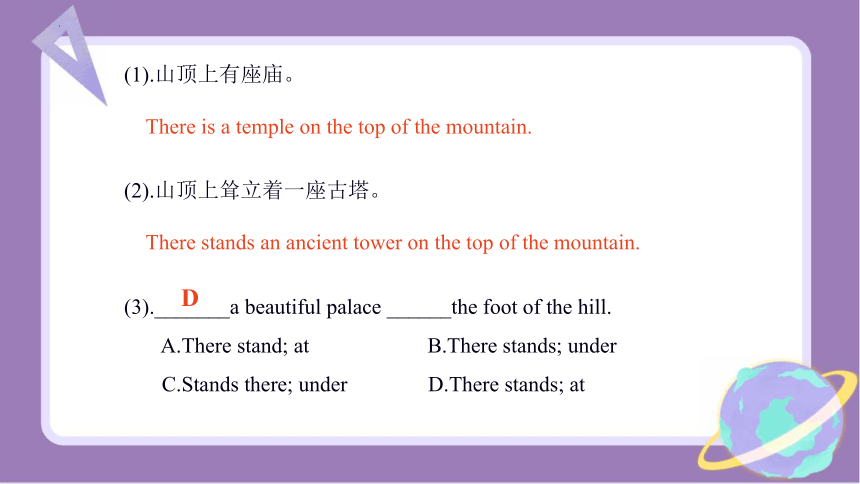
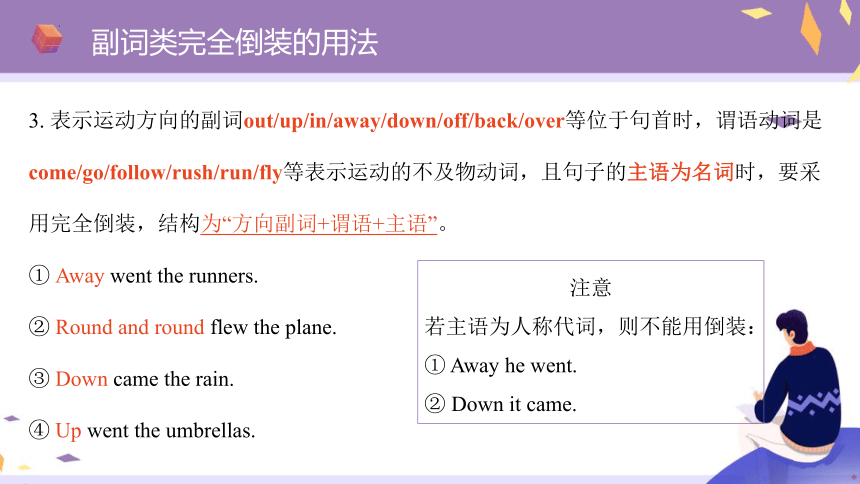
文档简介
(共53张PPT)
倒装句的定义
完 全 倒 装
部 分 倒 装
特 殊 句 型
在现实的语言实践中,由于语法结构的要求,或是由于修辞的需要,往往要改变句子的自然语序,把一些本应置于主语之后的句子成分提到主语之前。我们称这种语序的变化为“倒装语序”
什么是倒装语序?
一是主语在谓语之前称为自然语序(Natural Order)
I love my cat. (主+谓+宾)
This is a dog. (主+系+表)
二是主语在谓语之后则称为倒装语序(Inverted Order)
Here came the headmaster. (完全倒装)
Nerver will I forgive you. (部分倒装)
完全倒装(Full Inversion)是什么?
又称"全部倒装",是指将句子中的整个谓语置于主语之前。此结构通常只用于一般现在时和一般过去时。
例如:The teacher came in and the class began. (自然语序)
In came the teacher and the class began. (完全倒装)
My coat is here. (自然语序)
Here is my coat . (完全倒装)
副词类完全倒装的用法
Here’s Tom.
There goes the bell.
Now comes your turn.
Then came the chairman.
1. 以地点副词here, there和时间副词now, then开头,后面的动词是be, come, exist, fall, follow, go, lie, remain, seem, stand(表移动或动态的不及物动词)等,而主语又是名词时,构成完全倒装句,结构 “地点副词/时间副词+谓语+主语”。
Here is your letter.
Here comes the bus.
这是你的信。
公交车来了。
注意
(1) 以上倒装句中的谓语动词come和go不能用进行时态
(2) 若主语为代词,则不倒装:
① Here I am. ③There you are.
② Here you go. ④There it is.
副词类完全倒装的用法
2. there引出的完全倒装句:除了最常见的there be句型以外,there还可以接appear, exist, lie, remain, seem to be, stand等,一般都译成"有"的含义,构成完全倒装句。
There are many students in the classroom.
There appeared to be a man in black in the distance.
Once upon a time, there lived a man.
There stood a desk against the wall.
(1).山顶上有座庙。
(2).山顶上耸立着一座古塔。
(3)._______a beautiful palace ______the foot of the hill.
A.There stand; at B.There stands; under
C.Stands there; under D.There stands; at
There is a temple on the top of the mountain.
There stands an ancient tower on the top of the mountain.
D
副词类完全倒装的用法
3. 表示运动方向的副词out/up/in/away/down/off/back/over等位于句首时,谓语动词是come/go/follow/rush/run/fly等表示运动的不及物动词,且句子的主语为名词时,要采用完全倒装,结构为“方向副词+谓语+主语”。
① Away went the runners.
② Round and round flew the plane.
③ Down came the rain.
④ Up went the umbrellas.
注意
若主语为人称代词,则不能用倒装:
① Away he went.
② Down it came.
地点的介词短语置于句首, 且主语是名词(不是代词) , 需用完全倒装, 其形式为: “介词短语+谓语+主语”。 常用于此句型的谓语动词为 come, fall, follow, exist, lie, go, remain, run sit,walk等, 时态为一般现在时或一般过去时。
介词短语类完全倒装的用法
South of the city lies a big steel factory.
Under the tree stands a little boy.
From the house come the bursts of merry laughter
(1)在桌子下面睡着一只白色的猫。
(2)门后面站着一个女孩。
(3)窗户的前面坐着一位老妇人。
Behind the door stands a girl.
In the front of the window sits an old woman.
Under the table sleeps a white cat.
将以下句子翻译成英文
表语类完全倒装的用法
为了保持句子平衡或强调表语部分等, 将作表语的形容词、分词、介词、介词短语, 需用完全倒装, 其形式为: 形容词/现在分词/过去分词/such+系动词+主语。
Gone are the days when they could do what they liked.
Growing all over the mountain are wild flowers.
Among these people was his friend Jim.
Such were his words.
Lucky is he who has been enrolled into a famous university.
在表语置于句首的这类倒装结构中,要注意其中的谓语应与其后的主语保持一致,而不是与位于句首的表语保持一致。
比较:
① In the box was a cat. 箱子里是一只猫。
② In the box were some cats. 箱子里是一些猫。
(1).________ playing soldiers.
A. Inside the room were two boys B. Inside the room two boys
C. Were two boys inside the room D. Inside the room was two boys
(2).Over _______ , dead.
A. rolling the goat B. rolled the goat C. did the goat roll D. the goat rolled
(3).______ and the lesson began.
A. In came Mr Brown B. Mr Brown in came C. In came he D. came in Mr Brown
在以下四个选项中选出正确选项
A
B
A
(4) The door opened and there ________ .
A. enters an old man B. entered an old man
C. did an old man enter D. an old man entered
(5) —Where is my shirt, mum
—_________.
A. There is it B. There it is C. There is D. Here is it
(6)._______ who was wounded in the stomach.
A. Among them were a soldier B. Among them was a soldier
C. Among them a soldier was D. Among they was a soldier
B
B
B
将情态动词、助动词、be动词提到主语前。如果句中的谓语没有助动词或情态动词,则需添加助动词do,does或did,并将其置于主语之前。 “部分倒装=情态v/助v/be +主+谓 ”(通常可以还原为正常的语序,并以此检验倒装句是否正确。)
部分倒装(Partial Inversion)是什么?
Only in this way can you solve this problem.
Seldom do I go to work by bus.
用法1.表否定意义的词或短语
(1)否定词和一些表示否定意义的词或者短语置于句首时,应形成句子的部分倒装。
常见的否定词有:no, none , neither, nor , nobody, nothing , never, barely, hardly, rarely, little, seldom, scarely等
常见的否定短语有: at no time,by no means,by no manner of means, for no reason, in no case, in/under no circumstances, in no way, on no account等
Little did I know about you .
At no time can we give up learning.
Under no circumstances would we give up protecting the environment.
In no way am I going to adopt any of his methods.
Not a single book did I read this week.
Neither does a failure make you a loser.
(1) I would never do something like that.
(2) He say nothing before he left.
(3) He seldom goes to the cinema.
将以下句子改为部分倒装句
Never would I do something like that.
Nothing did he say before he left.
Seldom does he go to the cinema.
(2) 含有not...until...的句子中, not until...位于句首时,句子/主句用部分倒装,且必须将 until后面的全部内容提前,而不仅仅是not until这两个词。“主倒从不倒”
自然语序: He did not stop until he reached the door .
部分倒装:Not until he reached the door did he stop.
Not until the teacher came in did the students stop talking.
The students did not stop talking until the teacher came in.
They did not realize how serious the pollution was until all the fish died in the river.
Not until all the fish died in the river did they realize how serious the pollution was.
“主倒从不倒”
Not until they heard that she was safe were their minds set at rest.
Their minds were not set at rest until they heard that she was safe.
(3). no sooner...than...、hardly...when...(一......就......)中的 no sooner、hardly位于句首时,其所在句子要用部分倒装。
Scarcely/hardly + 过去完成时(had done)+ when+一般过去时(过去式)
No sooner + 过去完成时 (had done) + than+ 一般过去时(过去式)
自然语序:I had hardly got to the airport when the plane took off.
部分倒装:Hardly had I got to the airport when the plane took off.
The mouse had hardly come out when the cat caught it.
Hardly had the mouse come out when the cat caught it.
No sooner had I come home than it began to snow.
I had no sooner come home than it began to snow.
他们刚完成一个项目,新任务就来了。
Hardly had they finished a project when a new task came.
They had hardly finished a project when a new task came.
(4). 当not only..., but (also)...连接两个句子,not only 位于句首时, 含有not only 的分句要用部分倒装,but also后面的句子不倒装。
自然语序:He not only read the book, but also remembered what he had read.
部分倒装:Not only does he read the book,but also remembered what he had read.
Not only children but also adults are interested in the film Harry Potter.
注意:not only…but also...连接的是两个并列主语,位于句首时,不可倒装
他不仅英语说得好,就连日语也讲得很轻松自如。
Not only does he speak English well, but (also)he speaks Japanese easily.
He not only speak English well, but (also)he speaks Japanese easily.
(5). 当neither... nor...连接两个句子时, 句型中两个句子都需要部分倒装。而当他们连接两个并列的成分做主语时,则不用倒装。
自然语序: I neither wanted to see the film nor bought the ticket.
部分倒装:Neither did I want to see the film nor did I buy the ticket.
Neither has he done it, nor will he do it.
Neither Anna nor I are interested in high finance.
用法2. only强调状语置于句首
only + 状语/状语从句放在句首时,被该状语修饰的句子需要用部分倒装;但当only是主语时,不可倒装。
Only when I see him can my heartbeat speed up.
Only in this way can you learn English well.
Only after the war is over can people live a peaceful life.
Only socialism can save China.
1.只有用这种方法我们才能解决问题。
2.只有当他有空时,他才会来看我们。
3.只有那个男孩才能打开这扇门。
Only in this way can we solve the problem.
Only when he is free will he come to see us.
Only that boy can open the door.
4.Only in this way______make progress in your English.
A.you B .can you C.you be able to D.will you able to
5.Only when the meeting was over ______go back to meet his friends.
A.he could B.he was able to C.was he able to D.was able to he
B
C
(1)表示前面所说的肯定情况,也适合于另一人或物时,句式如下:
“ so + be (助动词或情态动词)+ 主语。”
① ----I've got an enormous amount of work to do.
----So have I. (我也是)
② You know that's true, and so do I.
③His father likes watching basketball games, (他妈妈也一样)
3. so / as / neither / nor 为标志词放在句首时,句子用倒装。
so does his mother
(2).表示前面所说的否定情况也适合于另一人或物时,句式如下:
“ neither (nor)+ be (助动词或情态动词)+ 主语 ”
If she doesn‘t agree to the plan, neither/nor will Tom.
I never learned to swim and neither/nor did they.
If they won't participate in the speech contest, .(他也不去)
neither/nor will she
① “so +主语+助动词(或be动词)”表示对上文肯定的内容加以肯定或赞同,意为“的确如此”。
— It's raining hard.
— So it is.
② “主语+did +so”表示:“主语”做了上文提到的事情。
Tom asked me to go to play football with him and I did so.
注意
用法4. 在 “so…that” 和 “ such…that”结构中
在 “so…that” 和 “ such…that”结构中,将“so+adj. ”和“such+n. ”提到句首时,句子用部分倒装, “so+adj. ”和“such+n. ”+ be动词/助动词/情态动词+主语。
Such a clever boy was Jack that he was able to work out all these difficult problems.
The storm was so terrible that the whole roof was blown off .
Jack was such a clever boy that he was able to work out all these difficult problems.
So terrible was the storm that the whole roof was blown off .
① So loudly______that ____hear her clearly.
A.did she speak;could everyone B.did she speak;everyone could
C.she spoke;could everyone D.she spoke;everyone could
② 这本书非常重要,无论如何都要出版。(at any cost无论如何, publish出版)
B
This book is so important that it must be published at any cost.
So important is this book that it must be published at any cost.
Such a important book is this that it must be published at any cost.
用法5. 在虚拟语气条件句中
从句谓语有助动词were, had, should时,可将if 省略,然后把 were, had, should 移到句首,形成句子的部分倒装。
If I had noticed the warning signs, none of this would have happened.
Had I noticed the warning signs, none of this would have happened.
注意:①若从句是否定句,则必须将 not放在主语后。
② had必须是助动词。
If I were you, I would go abroad.
If he should come, tell him to ring me up.
If you hadn't seen me in the water, I might have been drowned.
Had you not seen me in the water, I might have been drowned.
Were I you, I would go abroad.
Should he come, tell him to ring me up.
方式状语、频度状语提至句首时,常用部分倒装。常见的频度副词/短语:every day ,every other day , many a time(多次) , often,well等
用法6.方式状语、频度状语提至句首时
Often does he wear a sweet smile.
Many a time has John given me good advice.
Usually do I get up early.
Long did we wait before we heard from him.
用法7. as引导让步状语从句
as引导让步状语从句时,必须将表语、状语或动词原形提到as前面(部分倒装)。句子的倒装语序有以下三种形式:
(1). 形容词或副词+as+主语+连系动词be或实义动词。
① Rich as/though he is, he never spends a cent on clothes.
② Much as/though I admire his courage, I don’t think he acted wisely.
③ Stupid as/though it sounds,I was so in love with her that I believed her.
④Carefully as/though he worked,he made some mistakes .
尽管她已经老了,但是她坚持每天打篮球。(坚持:insist on)
Old as she is, she insists on playing basketball every day.
他虽说有耐心,也不想等这么久的公交车。
Patient as he is, he doesn't want to wait so long for the bus.
他虽然成功,但不骄傲。
Successful as he is,he is not proud.
(2). “名词+as+主语+连系动词be (注意句首的名词不带冠词)”。
① Child as/though he is, he knows a lot.
② Boy as/though he was, he was chosen king.
注意: 位于句首的名词前习惯上不用冠词,即使其前有形容词修饰也不用冠词
Boy as/though he is,he likes to play with girls.
=Though he is a boy,he likes to play with girls.
(3). “实义动词+as+主语+助动词/情态动词”
主语后的动词通常为may,might,would,did等情态动词或助动词
① Try as he may, he never succeeds.
② Change your mind as you will, you will gain no additional support.
③ Lose money as I did,we got a lot of experience.
若表示情态意义,则选用情态动词;若陈述事实,则用did,do等助动词如果没有助动词,则要加上一个do(does或did)。
在以下四个选项中选出正确选项
(1). So difficult _________ it to work out the problem that I decided to ask Tom for advice.
A. I did find B. did I find C. I have found D. have I found
(2). The old couple have been married for 40 years and never once __________ with each other.
A. they had quarrelled B. they have quarrelled
C. have they quarreled D. had they quarreled
(3). __________ can you expect to get a pay rise.
A. With hard work B. Although work hard
C. Only with hard work D. Now that he works hard
B
C
C
(4). _________ about wild plants that they decided to make a trip to Madagascar
for further research.
A. So curious the couple was B. So curious were the couple
C. How curious the couple were D. The couple was such curious
(5). Not only __________ interested in football but __________ beginning to show an
interest in it.
A. the teacher himself is; all his students are
B. the teacher himself is; are all his students
C. is the teacher himself; are all his students
D. is the teacher himself; all his students are
B
D
(6). At no time and under no circumstances the dream!
A. should we abandon B we should abandon
C. we didn’t abandon D. should we abandoned
(7) _______ and caught the mouse.
A. Up the cat jumped B. The cat up jumped
C. Up jumped the cat D. Jumped up the cat
(8) Hardly ________ his homework when he went out.
A. finished he B. he had finished C. had he finish D. had he finished
A
C
D
(9). Many a time me with my experiment.
A. has he helped B. he has helped C. he helped D. has helped he
(10).She plays the piano very well, ______.
A. so every one of us does B. every one of us does
C. so does every one of us D. so do every one of us
A
C
1. 在直接引语之后,“主语+ say/ ask之类的动词”可以用正语序,也可以倒装,在书面语中常用全部倒装。
①“What do you mean ” asked Henry. (or:…Henry asked.)
②“I am aware of that,” replied the Englishman.
③“Please go away.” said one child.
但是,主语是代词时不用倒装。
“What do you mean ” he asked.
2. 用于表示祝愿/意愿的句型
(1)这种祈求性虚拟语气一般只用于几种相当固定的说法中,需要用到倒装。
① Long live the People’s Republic of China!(中华人民共和国万岁!)完全倒装
② Far be it from me to tell you what to do. (我是不会告诉你干些什么的)部分倒装
(2)“may +主语+谓语”这种结构表示一种愿望或诅咒,这里是部分倒装。
① May you live a long and happy life!
② May the best man win!
③ May you break your neck!
3.感叹句
感叹句通常采用正语序,即主语在前,谓语在后。但有时感叹句采用的却是疑问句的形式。尤其是在美国英语中,感叹句常常象普通疑问句。
① Isn’t it cold! 真冷!
② Am I fed up! 我腻烦死了!
③ Did he look annoyed! 他看来可气恼了!
倒装句的定义
完 全 倒 装
部 分 倒 装
特 殊 句 型
在现实的语言实践中,由于语法结构的要求,或是由于修辞的需要,往往要改变句子的自然语序,把一些本应置于主语之后的句子成分提到主语之前。我们称这种语序的变化为“倒装语序”
什么是倒装语序?
一是主语在谓语之前称为自然语序(Natural Order)
I love my cat. (主+谓+宾)
This is a dog. (主+系+表)
二是主语在谓语之后则称为倒装语序(Inverted Order)
Here came the headmaster. (完全倒装)
Nerver will I forgive you. (部分倒装)
完全倒装(Full Inversion)是什么?
又称"全部倒装",是指将句子中的整个谓语置于主语之前。此结构通常只用于一般现在时和一般过去时。
例如:The teacher came in and the class began. (自然语序)
In came the teacher and the class began. (完全倒装)
My coat is here. (自然语序)
Here is my coat . (完全倒装)
副词类完全倒装的用法
Here’s Tom.
There goes the bell.
Now comes your turn.
Then came the chairman.
1. 以地点副词here, there和时间副词now, then开头,后面的动词是be, come, exist, fall, follow, go, lie, remain, seem, stand(表移动或动态的不及物动词)等,而主语又是名词时,构成完全倒装句,结构 “地点副词/时间副词+谓语+主语”。
Here is your letter.
Here comes the bus.
这是你的信。
公交车来了。
注意
(1) 以上倒装句中的谓语动词come和go不能用进行时态
(2) 若主语为代词,则不倒装:
① Here I am. ③There you are.
② Here you go. ④There it is.
副词类完全倒装的用法
2. there引出的完全倒装句:除了最常见的there be句型以外,there还可以接appear, exist, lie, remain, seem to be, stand等,一般都译成"有"的含义,构成完全倒装句。
There are many students in the classroom.
There appeared to be a man in black in the distance.
Once upon a time, there lived a man.
There stood a desk against the wall.
(1).山顶上有座庙。
(2).山顶上耸立着一座古塔。
(3)._______a beautiful palace ______the foot of the hill.
A.There stand; at B.There stands; under
C.Stands there; under D.There stands; at
There is a temple on the top of the mountain.
There stands an ancient tower on the top of the mountain.
D
副词类完全倒装的用法
3. 表示运动方向的副词out/up/in/away/down/off/back/over等位于句首时,谓语动词是come/go/follow/rush/run/fly等表示运动的不及物动词,且句子的主语为名词时,要采用完全倒装,结构为“方向副词+谓语+主语”。
① Away went the runners.
② Round and round flew the plane.
③ Down came the rain.
④ Up went the umbrellas.
注意
若主语为人称代词,则不能用倒装:
① Away he went.
② Down it came.
地点的介词短语置于句首, 且主语是名词(不是代词) , 需用完全倒装, 其形式为: “介词短语+谓语+主语”。 常用于此句型的谓语动词为 come, fall, follow, exist, lie, go, remain, run sit,walk等, 时态为一般现在时或一般过去时。
介词短语类完全倒装的用法
South of the city lies a big steel factory.
Under the tree stands a little boy.
From the house come the bursts of merry laughter
(1)在桌子下面睡着一只白色的猫。
(2)门后面站着一个女孩。
(3)窗户的前面坐着一位老妇人。
Behind the door stands a girl.
In the front of the window sits an old woman.
Under the table sleeps a white cat.
将以下句子翻译成英文
表语类完全倒装的用法
为了保持句子平衡或强调表语部分等, 将作表语的形容词、分词、介词、介词短语, 需用完全倒装, 其形式为: 形容词/现在分词/过去分词/such+系动词+主语。
Gone are the days when they could do what they liked.
Growing all over the mountain are wild flowers.
Among these people was his friend Jim.
Such were his words.
Lucky is he who has been enrolled into a famous university.
在表语置于句首的这类倒装结构中,要注意其中的谓语应与其后的主语保持一致,而不是与位于句首的表语保持一致。
比较:
① In the box was a cat. 箱子里是一只猫。
② In the box were some cats. 箱子里是一些猫。
(1).________ playing soldiers.
A. Inside the room were two boys B. Inside the room two boys
C. Were two boys inside the room D. Inside the room was two boys
(2).Over _______ , dead.
A. rolling the goat B. rolled the goat C. did the goat roll D. the goat rolled
(3).______ and the lesson began.
A. In came Mr Brown B. Mr Brown in came C. In came he D. came in Mr Brown
在以下四个选项中选出正确选项
A
B
A
(4) The door opened and there ________ .
A. enters an old man B. entered an old man
C. did an old man enter D. an old man entered
(5) —Where is my shirt, mum
—_________.
A. There is it B. There it is C. There is D. Here is it
(6)._______ who was wounded in the stomach.
A. Among them were a soldier B. Among them was a soldier
C. Among them a soldier was D. Among they was a soldier
B
B
B
将情态动词、助动词、be动词提到主语前。如果句中的谓语没有助动词或情态动词,则需添加助动词do,does或did,并将其置于主语之前。 “部分倒装=情态v/助v/be +主+谓 ”(通常可以还原为正常的语序,并以此检验倒装句是否正确。)
部分倒装(Partial Inversion)是什么?
Only in this way can you solve this problem.
Seldom do I go to work by bus.
用法1.表否定意义的词或短语
(1)否定词和一些表示否定意义的词或者短语置于句首时,应形成句子的部分倒装。
常见的否定词有:no, none , neither, nor , nobody, nothing , never, barely, hardly, rarely, little, seldom, scarely等
常见的否定短语有: at no time,by no means,by no manner of means, for no reason, in no case, in/under no circumstances, in no way, on no account等
Little did I know about you .
At no time can we give up learning.
Under no circumstances would we give up protecting the environment.
In no way am I going to adopt any of his methods.
Not a single book did I read this week.
Neither does a failure make you a loser.
(1) I would never do something like that.
(2) He say nothing before he left.
(3) He seldom goes to the cinema.
将以下句子改为部分倒装句
Never would I do something like that.
Nothing did he say before he left.
Seldom does he go to the cinema.
(2) 含有not...until...的句子中, not until...位于句首时,句子/主句用部分倒装,且必须将 until后面的全部内容提前,而不仅仅是not until这两个词。“主倒从不倒”
自然语序: He did not stop until he reached the door .
部分倒装:Not until he reached the door did he stop.
Not until the teacher came in did the students stop talking.
The students did not stop talking until the teacher came in.
They did not realize how serious the pollution was until all the fish died in the river.
Not until all the fish died in the river did they realize how serious the pollution was.
“主倒从不倒”
Not until they heard that she was safe were their minds set at rest.
Their minds were not set at rest until they heard that she was safe.
(3). no sooner...than...、hardly...when...(一......就......)中的 no sooner、hardly位于句首时,其所在句子要用部分倒装。
Scarcely/hardly + 过去完成时(had done)+ when+一般过去时(过去式)
No sooner + 过去完成时 (had done) + than+ 一般过去时(过去式)
自然语序:I had hardly got to the airport when the plane took off.
部分倒装:Hardly had I got to the airport when the plane took off.
The mouse had hardly come out when the cat caught it.
Hardly had the mouse come out when the cat caught it.
No sooner had I come home than it began to snow.
I had no sooner come home than it began to snow.
他们刚完成一个项目,新任务就来了。
Hardly had they finished a project when a new task came.
They had hardly finished a project when a new task came.
(4). 当not only..., but (also)...连接两个句子,not only 位于句首时, 含有not only 的分句要用部分倒装,but also后面的句子不倒装。
自然语序:He not only read the book, but also remembered what he had read.
部分倒装:Not only does he read the book,but also remembered what he had read.
Not only children but also adults are interested in the film Harry Potter.
注意:not only…but also...连接的是两个并列主语,位于句首时,不可倒装
他不仅英语说得好,就连日语也讲得很轻松自如。
Not only does he speak English well, but (also)he speaks Japanese easily.
He not only speak English well, but (also)he speaks Japanese easily.
(5). 当neither... nor...连接两个句子时, 句型中两个句子都需要部分倒装。而当他们连接两个并列的成分做主语时,则不用倒装。
自然语序: I neither wanted to see the film nor bought the ticket.
部分倒装:Neither did I want to see the film nor did I buy the ticket.
Neither has he done it, nor will he do it.
Neither Anna nor I are interested in high finance.
用法2. only强调状语置于句首
only + 状语/状语从句放在句首时,被该状语修饰的句子需要用部分倒装;但当only是主语时,不可倒装。
Only when I see him can my heartbeat speed up.
Only in this way can you learn English well.
Only after the war is over can people live a peaceful life.
Only socialism can save China.
1.只有用这种方法我们才能解决问题。
2.只有当他有空时,他才会来看我们。
3.只有那个男孩才能打开这扇门。
Only in this way can we solve the problem.
Only when he is free will he come to see us.
Only that boy can open the door.
4.Only in this way______make progress in your English.
A.you B .can you C.you be able to D.will you able to
5.Only when the meeting was over ______go back to meet his friends.
A.he could B.he was able to C.was he able to D.was able to he
B
C
(1)表示前面所说的肯定情况,也适合于另一人或物时,句式如下:
“ so + be (助动词或情态动词)+ 主语。”
① ----I've got an enormous amount of work to do.
----So have I. (我也是)
② You know that's true, and so do I.
③His father likes watching basketball games, (他妈妈也一样)
3. so / as / neither / nor 为标志词放在句首时,句子用倒装。
so does his mother
(2).表示前面所说的否定情况也适合于另一人或物时,句式如下:
“ neither (nor)+ be (助动词或情态动词)+ 主语 ”
If she doesn‘t agree to the plan, neither/nor will Tom.
I never learned to swim and neither/nor did they.
If they won't participate in the speech contest, .(他也不去)
neither/nor will she
① “so +主语+助动词(或be动词)”表示对上文肯定的内容加以肯定或赞同,意为“的确如此”。
— It's raining hard.
— So it is.
② “主语+did +so”表示:“主语”做了上文提到的事情。
Tom asked me to go to play football with him and I did so.
注意
用法4. 在 “so…that” 和 “ such…that”结构中
在 “so…that” 和 “ such…that”结构中,将“so+adj. ”和“such+n. ”提到句首时,句子用部分倒装, “so+adj. ”和“such+n. ”+ be动词/助动词/情态动词+主语。
Such a clever boy was Jack that he was able to work out all these difficult problems.
The storm was so terrible that the whole roof was blown off .
Jack was such a clever boy that he was able to work out all these difficult problems.
So terrible was the storm that the whole roof was blown off .
① So loudly______that ____hear her clearly.
A.did she speak;could everyone B.did she speak;everyone could
C.she spoke;could everyone D.she spoke;everyone could
② 这本书非常重要,无论如何都要出版。(at any cost无论如何, publish出版)
B
This book is so important that it must be published at any cost.
So important is this book that it must be published at any cost.
Such a important book is this that it must be published at any cost.
用法5. 在虚拟语气条件句中
从句谓语有助动词were, had, should时,可将if 省略,然后把 were, had, should 移到句首,形成句子的部分倒装。
If I had noticed the warning signs, none of this would have happened.
Had I noticed the warning signs, none of this would have happened.
注意:①若从句是否定句,则必须将 not放在主语后。
② had必须是助动词。
If I were you, I would go abroad.
If he should come, tell him to ring me up.
If you hadn't seen me in the water, I might have been drowned.
Had you not seen me in the water, I might have been drowned.
Were I you, I would go abroad.
Should he come, tell him to ring me up.
方式状语、频度状语提至句首时,常用部分倒装。常见的频度副词/短语:every day ,every other day , many a time(多次) , often,well等
用法6.方式状语、频度状语提至句首时
Often does he wear a sweet smile.
Many a time has John given me good advice.
Usually do I get up early.
Long did we wait before we heard from him.
用法7. as引导让步状语从句
as引导让步状语从句时,必须将表语、状语或动词原形提到as前面(部分倒装)。句子的倒装语序有以下三种形式:
(1). 形容词或副词+as+主语+连系动词be或实义动词。
① Rich as/though he is, he never spends a cent on clothes.
② Much as/though I admire his courage, I don’t think he acted wisely.
③ Stupid as/though it sounds,I was so in love with her that I believed her.
④Carefully as/though he worked,he made some mistakes .
尽管她已经老了,但是她坚持每天打篮球。(坚持:insist on)
Old as she is, she insists on playing basketball every day.
他虽说有耐心,也不想等这么久的公交车。
Patient as he is, he doesn't want to wait so long for the bus.
他虽然成功,但不骄傲。
Successful as he is,he is not proud.
(2). “名词+as+主语+连系动词be (注意句首的名词不带冠词)”。
① Child as/though he is, he knows a lot.
② Boy as/though he was, he was chosen king.
注意: 位于句首的名词前习惯上不用冠词,即使其前有形容词修饰也不用冠词
Boy as/though he is,he likes to play with girls.
=Though he is a boy,he likes to play with girls.
(3). “实义动词+as+主语+助动词/情态动词”
主语后的动词通常为may,might,would,did等情态动词或助动词
① Try as he may, he never succeeds.
② Change your mind as you will, you will gain no additional support.
③ Lose money as I did,we got a lot of experience.
若表示情态意义,则选用情态动词;若陈述事实,则用did,do等助动词如果没有助动词,则要加上一个do(does或did)。
在以下四个选项中选出正确选项
(1). So difficult _________ it to work out the problem that I decided to ask Tom for advice.
A. I did find B. did I find C. I have found D. have I found
(2). The old couple have been married for 40 years and never once __________ with each other.
A. they had quarrelled B. they have quarrelled
C. have they quarreled D. had they quarreled
(3). __________ can you expect to get a pay rise.
A. With hard work B. Although work hard
C. Only with hard work D. Now that he works hard
B
C
C
(4). _________ about wild plants that they decided to make a trip to Madagascar
for further research.
A. So curious the couple was B. So curious were the couple
C. How curious the couple were D. The couple was such curious
(5). Not only __________ interested in football but __________ beginning to show an
interest in it.
A. the teacher himself is; all his students are
B. the teacher himself is; are all his students
C. is the teacher himself; are all his students
D. is the teacher himself; all his students are
B
D
(6). At no time and under no circumstances the dream!
A. should we abandon B we should abandon
C. we didn’t abandon D. should we abandoned
(7) _______ and caught the mouse.
A. Up the cat jumped B. The cat up jumped
C. Up jumped the cat D. Jumped up the cat
(8) Hardly ________ his homework when he went out.
A. finished he B. he had finished C. had he finish D. had he finished
A
C
D
(9). Many a time me with my experiment.
A. has he helped B. he has helped C. he helped D. has helped he
(10).She plays the piano very well, ______.
A. so every one of us does B. every one of us does
C. so does every one of us D. so do every one of us
A
C
1. 在直接引语之后,“主语+ say/ ask之类的动词”可以用正语序,也可以倒装,在书面语中常用全部倒装。
①“What do you mean ” asked Henry. (or:…Henry asked.)
②“I am aware of that,” replied the Englishman.
③“Please go away.” said one child.
但是,主语是代词时不用倒装。
“What do you mean ” he asked.
2. 用于表示祝愿/意愿的句型
(1)这种祈求性虚拟语气一般只用于几种相当固定的说法中,需要用到倒装。
① Long live the People’s Republic of China!(中华人民共和国万岁!)完全倒装
② Far be it from me to tell you what to do. (我是不会告诉你干些什么的)部分倒装
(2)“may +主语+谓语”这种结构表示一种愿望或诅咒,这里是部分倒装。
① May you live a long and happy life!
② May the best man win!
③ May you break your neck!
3.感叹句
感叹句通常采用正语序,即主语在前,谓语在后。但有时感叹句采用的却是疑问句的形式。尤其是在美国英语中,感叹句常常象普通疑问句。
① Isn’t it cold! 真冷!
② Am I fed up! 我腻烦死了!
③ Did he look annoyed! 他看来可气恼了!
同课章节目录
